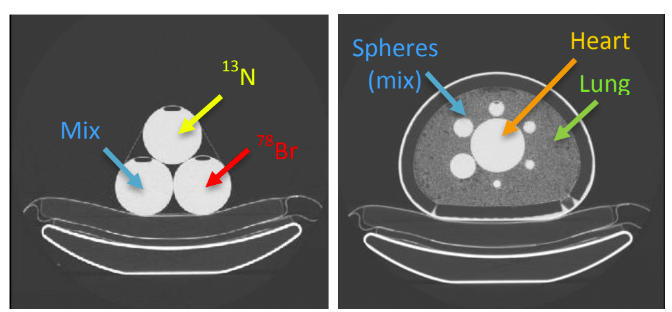Simultaneous PET Imaging of Liquid Absorption and Mucociliary Transport in the Lungs Based on Triple Coincidences

| AUTHORS | |
| JOURNAL | IEEE Nuclear Science Symposium & Medical Imaging conference |
| ABSTRACT |
Triple coincidences in PET can be used to enable the simultaneous imaging and separation of radiotracers labeled with standard positron emitters (such as 13N) and positron-gamma emitters (such as 76 Br). We have previously shown that multiplexed PET can be achieved without any kinetic modelling or hardware modification, and therefore it can be used in most current PET scanners. The goal of this study was to demonstrate that this methodology can be applied to solve important clinical needs, such as the quantitative measurement of the liquid absorption in the airways, a new biomarker for the treatment response of Cystic Fibrosis (CF) patients.
To measure LA in the lungs we plan to use simultaneous measurements of the local transport in the airways of a small molecule (13 N-NH3), which is cleared by both LA and muco-ciliary transport (MCT), and a large molecule (Albumin-microagregate,76 Br-Alb-Ma) that is transported exclusively by MCT. LA can be then calculated based on the differences on transport rates of both tracers. We evaluated the performance of the proposed method in a clinical PET/CT scanner with 10-minutes acquisitions of phantoms filled with 13 N-NH3 and 76 Br (~0.25 μCi/cc). After simultaneous acquisition, list-mode data were analyzed to classify events into double coincidences (which contains events from both tracers) and triple coincidences (mostly from positron-gamma events). Following the reconstruction of each dataset, an iterative Maximum-Likelihood algorithm provides separated images of each tracer. Images were quantitative in each region containing 76 Br, 13 N, or both (<5 % bias respect to the actual values). The image quality and quantitative accuracy obtained in this preliminary experiment is much better than the one achievable with other techniques such as dual-tracer scintigraphy. In-vivo experiments with pigs are currently being performed and the results will be presented at the conference. |
| LINK | Link |



